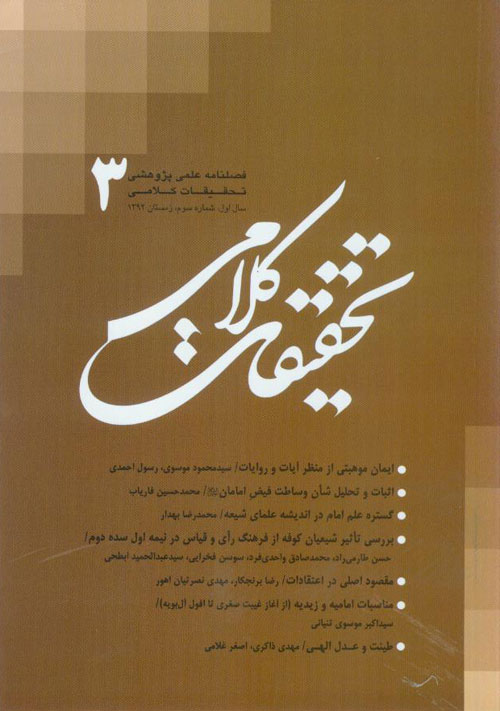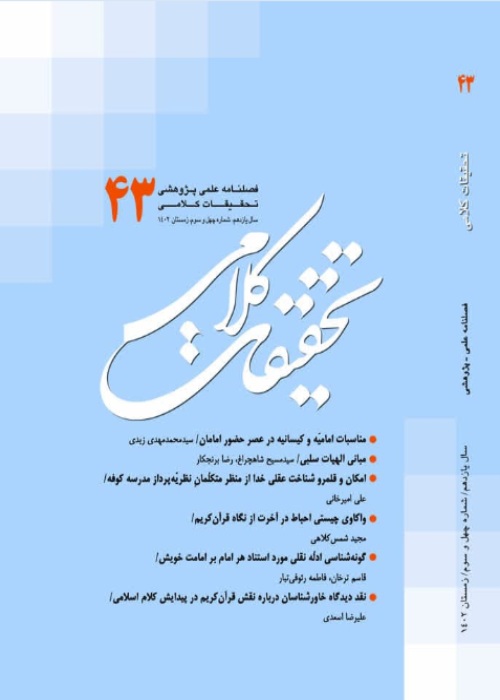فهرست مطالب

فصلنامه تحقیقات کلامی
پیاپی 3 (زمستان 1392)
- تاریخ انتشار: 1393/03/06
- تعداد عناوین: 7
-
-
صفحه 7
«ایمان» از اساسی ترین مفاهیم اعتقادی اسلام است، که آن را به اعتقاد قلبی همراه با اقرار زبانی و عمل جوارحی معنا می کنند. مطابق آیات و روایات، ایمان آن گاه محقق می شود که مسبوق به معرفتی باشد. این معرفت هم می تواند اکتسابی باشد و هم فیض و عنایت الهی آن را برای انسان حاصل کند.
البته در هر دو صورت، تصدیق آن معرفت (قلبی یا لسانی) در حوزه اختیار انسان تعریف می شود. ایمانی که از این فرآیند حاصل می شود اکتسابی است و زیربنای ایمانی قرار می گیرد که بر اساس تعابیر روایات، آن را «ایمان موهبتی» می نامیم. ایمان موهبتی، ایمانی است که در ورای ایمان مصطلح قرار داشته و بنا بر آیات و روایات، عطیه و نوری است که بر قلب مومن تابانده می شود. نوشتار حاضر بر آن است که به مستندات روایی و قرآنی این نوع از ایمان بپردازد.کلیدواژگان: ایمان، اختیار، هدایت، اعطا، سکینه، نور ایمان، روح ایمان -
صفحه 23
بر اساس روایات پرشمار، «وساطت فیض» یکی از شئون تکوینی امامان علیهم السلام است. مقصود از وساطت فیض، آن است که خداوند به واسطه ایشان نعمت های خاص و عام خود را بر بندگانش فرو می فرستد. در معنایی بالاتر، این عالم و پایداری آن چیزی جز فیض خداوند نیست که خداوند چنین فیضی را به واسطه وجود امامان علیهم السلام انجام می دهد. نگارنده در این پژوهش، با رویکردی نقلی به اثبات این شان و تحلیل آن پرداخته است. اگرچه در نگاه نخست، شان وساطت فیض غالیانه می نماید و ممکن است مورد انکار برخی قرار گیرد، در روایات معتبر و متعددی این شان برای امامان علیهم السلام ثابت شده است.
کلیدواژگان: امام، وساطت فیض جزئی، وساطت فیض کلی، غلو، توحید -
صفحه 39
«علم امام» از مسائلی است که همواره اذهان علما و متفکران شیعی و حتی بسیاری از پیروان ائمه علیهم السلام را به خود مشغول کرده است. بدین روی، سبب ایجاد پرسش هایی از ائمه اطهار علیهم السلام در این باره شده است. با توجه به پرسش های متعددی که در این زمینه مطرح است، این نوشتار تنها از یک منظر به این مسئله می پردازد که آن، علم امام از منظر علمای شیعه است؛ به این که شعاع این علم چه مقدار است و تا کجا امتداد و وسعت دارد. با وجود وحدت نظر اندیشمندان شیعی در برخی حوزه های بحث علم امام، در بعضی موارد از جمله پرسش مزبور، پاسخ های واحدی دریافت نمی شود و به طور کلی، همه نظریه ها را می توان در سه دیدگاه تقسیم کرد: رویکرد تردید و سکوت؛ رویکرد محدودیت علم امام؛ رویکرد احاطه علمی کامل امام به همه چیز.
کلیدواژگان: امام، علم، علم غیب، علمای شیعه -
صفحه 59
توسعه فرهنگ رای و قیاس در سده اول، به گونه ای مکمل و جبران کننده فقدان دست رسی به وحی شده بود و دست کم در موارد نبود موضوعی در کتاب و سنت، مسائل از طریق رای و اجتهاد حل می شد. توسعه این روال در نظام فقهی و قضایی رایج موجب شد، افراد بسیاری آن را امری عادی تلقی کنند. این فرهنگ در میان برخی شیعیان عمدتا کوفی که تازه هدایت شده یا بیشتر با جریان عامه در تعامل بودند، تاثیراتی را آشکار کرده بود، و امام صادق (علیه السلام) تلاش کردند شیعیان را از لغرشگاه های این فرهنگ دور کنند. مقاله حاضر می کوشد به بررسی تاثر شیعیان کوفه از این فرهنگ در نیمه اول سده دوم بپردازد.
کلیدواژگان: قیاس، رای، تفویض، شیعیان کوفه، اجتهاد، معضلات -
صفحه 75
یکی از مباحث مهم کلامی که فقط در کتاب های اصولی از آن بحثی گذرا شده، تعیین مقصود اصلی در واجبات اعتقادی است. دراین باره، دو دیدگاه عمده وجود دارد: «معرفت عقلی» و «تدین و اعتقاد ورزی». پیروان هر یک از این دو دیدگاه در صددند تا اثبات کنند یکی از وجوب ها نفسی و دیگری مقدمه یا متولد از آن است. در این مقاله، دلایل دو نظریه بررسی و در نهایت نظریه دوم برگزیده شد.
کلیدواژگان: معرفت عقلی، دل سپردن، تدین، اعتقاد، واجب اعتقادی، معرفت الله -
صفحه 89
زیدیه و امامیه از دیرینه ترین گروه های اسلامی اند. آگاهی از روابط این دو نحله اثرگذار، برای شناخت بهتر تاریخ فکری تشیع ره گشاست. در این نوشتار سعی شده است، تعامل اجتماعی، سیاسی و فرهنگی و نیز تقابل این دو گروه در دوره غیبت صغرا تا افول آل بویه (دوره اقتدار تشیع در جهان اسلام) بررسی شود. واکاوی گزارش های تاریخی نشان گر این است که در این دوره، همکاری زیدیان و امامیان در عرصه های گوناگون، روند رو به رشدی داشته است؛ البته به دلیل اختلاف در برخی از مبانی فکری، هم چنان تمایزگذاری فرقه ای خویش را در قالب مناظره های علمی و ردیه نگاری دنبال کرده اند.
کلیدواژگان: امامیه، زیدیه، تعامل اجتماعی، تقابل علمی، تعامل فرهنگی -
صفحه 111
در احادیث متعدد و معتبری، از اختلاف طینت مومنان و کافران سخن به میان آمده است. بر اساس این احادیث، اختلاف طینت ها در سعادت و شقاوت افراد موثر است. برخی اندیشمندان ظاهر این احادیث را با عدل الهی ناسازگار پنداشته، در صدد توجیه و تاویل آن ها برآمده اند. این مقاله پس از طرح و ارزیابی مهم ترین دیدگاه ها در این زمینه، با استناد به مجموع احادیث طینت و آغاز حدوث عالم نتیجه گرفته است که اختلاف مخلوقات مربوط به ابتدای حدوث عالم نیست، بلکه بر اثر عوارض ناشی از نحوه عملکرد مخلوقات در برابر تکلیف و امتحان الهی رخ داده است و این موضوع با عدل الهی سازگاری تام دارد.
کلیدواژگان: عدل الهی، خلقت انسان، طینت، علیین، سجین
-
Page 7
Faith is regadedan the most fundamental concept in the doctrinal system of shiism as well as Islam.It is defined as acknowledge by heart along with confession by tongue and action by bodily parts(limbs).Whether or not the confession and action are considered as part of the nature of faith concomitant of it , faith is preceded by some knowledge. This knowledge can be obtained an result of one,s attempts or given to human being due to grace of Allah. In either case the acknowledgement by tongue or heart is an act of human free will. Accordingly faith attaind in this way is an acquired one which paves the way for what is called in the traditions a God given or giyted faith. God given faith is beyond that in technical sense and according to holy verses and hadiths is a light and gift of god bestowed to the chosen individuals. This article is an attempt to explain the approach to holy verses and hadith through which one can see clearly the nature of faith an a gift by God to human being.
Keywords: Faith, free will, blessing, guidance, bestowing, tranquility, light of faith, spirir of faith -
Page 23
According to numerous accounts “mediation of grace" is one of the developmental aspects of the Infallible Imams peace be upon them. The purpose of the mediation of grace is that God sends down his general and special blessings on His slaves through them. At a higher semantic level the world and its stability is nothing but grace of God. It is done by virtue of the Infallible Imams peace be upon them. Using traditions, the author of this study tries to analyze and demonstrate the dignity. Although at first glance, the dignity of mediation seems to be exaggerated and may be denied, it is easily proved by the numerous authentic traditions.
Keywords: Imami Shia, Partial Mediation of Grace, General Mediationof Grace, Exaggeration, Monotheism -
Page 39
Imam’s Knowledge is one of the issues that have busied the minds of the Shia scholars and thinkers and even many of the followers of the Imams. Thus, it brought about some questions from Imams in this regard. Due to the many questions that arise in this context, this paper deals with only one aspect of the problem that is Imam’s Knowledge as viewed by the Shia clerics; what is the extent of this knowledge and how much is it? Despite the Shia scholars’ agreement in some fields of Imam’s Knowledge, we do not find an adequate answer in some cases, including the above mentioned questions. Generally speaking, all theories can be divided into three approaches: the first approach, doubt and silence; the second approach, the scope of Imam’s Knowledge; the third approach, Imam’s full scientific comprehension of everything.
Keywords: Imam, Knowledge, Prescience, the Shia Clerics -
Page 59
Development of the culture of Ra’y and Qiyyas in the first century, to serve as a complement to offset the lack of availability of Revelation, at least the lack of related issues in the Book and the Sunnah, they were resolved through Ra’y and Ijtihad. Development of this process in the current legal and judicial system caused many people consider it normal. The culture had revealed some effects among some Shia who were newly guided or those who had more interaction with the public. Imam Sadiq (peace be upon him) tried to take them away from the faults of this culture. The present article attempts to examine the influence of Ra’y and Qiyyas on the Shia of Kufa in the first half of the second century.
Keywords: Ra’y, Qiyyas, Comparison, Opinion, Delegation, theShia of Kufa, Ijtihad, Problems -
Page 75
Determining the main objective of the religious obligations, discussed briefly in Usul books, is one of the important theological issues. There are two main perspectives in this regard: "rational understanding" and "religion and belief." The followers of each of these two perspectives are trying to prove that one of the obligations is inherent and the other is born out of it. This paper reviews the reasons of two theories and finally the latter is chosen.
Keywords: Intellectual Knowledge, Infatuation, Piety, Believe, ReligiousObligatory, Knowledge of God -
Page 89
Imamia and Zaidiyya are the oldest groups in the world of Islam. Knowledge of the relationship between the two major factions contributes to a better understanding of intellectual history of Shia. In this article we try to review social, political and cultural relationship as well as interactions between the two groups during the period of the lesser occultation to the decline of the Buyids (Ale Buyah), the age of the authority of the Shia in the world of Islam. Analyzing historical records, we conclude that in this period, cooperation between Zaidis and Imamis in various fields had a growing trend, but due to some differences in belief, they have maintained their ethnic distinction in scientific debate and writing books of rejection.
Keywords: Imami Shia, Zaidiyya, Social Interactions, ScientificReciprocity, Cultural Interactions -
Page 111
Many reliable hadiths speak of the differences between inner nature of believers and unbelievers. According to these hadiths, the differences are effective in their prosperity and adversity. Some scholars deemed that these traditions are apparently incompatible with divine justice. They have begun to seek an explanation and interpretation for them. After evaluation of the most important ideas in this area and referring to the total traditions concerning the inner nature and beginning of the creation of the world, the authors of the present paper have concluded that the differences between human creatures do not pertain to the beginning of the creation of the world, but due to complications of human functions in doing divine assignments and tests and it has complete compatibility with divine justice.
Keywords: Divine Justice, Human Creation, Tinat (Inner Nature), Illiyyn(the Highest), Sijjiyyn (the Lowest)


